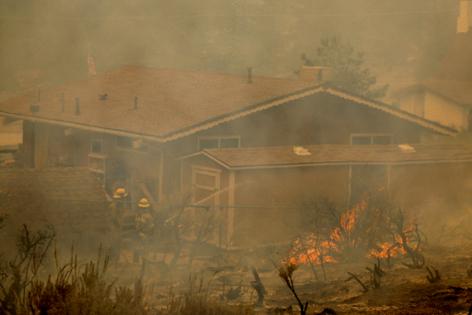Commentary: How a California community helped prevent the Bridge fire from destroying their town
Published in Op Eds
On the evening of Sept. 10, things looked bad for the mountain ski town of Wrightwood in the San Gabriel Mountains, northeast of Los Angeles. Driven by extreme fire weather, the Bridge fire, which had started on the other side of the mountain range, grew from just a few thousand acres to 34,240 acres that day, and was spreading toward the town. By the next morning, it had reached Wrightwood’s boundaries.
This could have been a catastrophe, like the Camp fire in 2018, which claimed dozens of lives and destroyed thousands of homes in the northern Sierra Nevada town of Paradise. Instead, out of more than 2,000 residences in Wrightwood, 13 were destroyed by the Bridge fire. It’s tragic that homes were lost, yet the fact that more than 99% of residences survived and all of the people were safely evacuated is a significant wildfire success story. What explains it?
In recent years, Wrightwood got very serious about community fire-safety measures. Long before the Bridge fire began, the local Fire Safe Council held educational events, coordinating with multiple agencies and governments. They promoted the importance of simple “home hardening” measures to make homes more fireproof, such as sweeping pine needles and leaves off of roofs and installing modern exterior vents that prevent flaming embers from entering houses. They preached about the effectiveness of “defensible space,” advocating that residents prune grasses, saplings and lower limbs immediately adjacent to their homes. And they created an evacuation plan.
The Bridge fire is still burning, but slowly being brought under control. It’s currently 81% contained, with some zones still under evacuation and evacuation warning. As it threatened Wrightwood, wildland firefighting teams prioritized the kind of direct community protection the town had been preparing its residents for, rather than focusing on remote wildland areas, and trying to stop a wind-driven fire that could not realistically be stopped.
They found that most homes in the town had defensible space, thanks to pruning done by owners. Firefighters concentrated aerial drops of fire retardant and water adjacent to the community, to keep the fire from entering the town. And they helped people evacuate, following the plan the townspeople had made.
Wrightwood’s success in keeping most of its homes safe demonstrates that focusing directly on at-risk communities, rather than on forest management activities out in the wildlands, is a significant way to protect towns from wildfires. We have seen the grim results of logging vast areas of remote forest under the guise of “thinning” and telling communities that these zones would act as fuel breaks, preventing wildfires from reaching towns. Paradise, Greenville (destroyed in the Dixie fire in 2021) and Grizzly Flats, which is still rebuilding after two-thirds of it was lost to the Caldor fire that same year, are all examples of the fallacy of this approach.
Yet there are those who would ignore examples like Wrightwood and want to double down on the failed strategies of the past. The most dangerous current example is the deceptively named Fix Our Forests Act, a bill sponsored by Rep. Bruce Westerman, R-Ark. If passed it would roll back bedrock environmental laws and allow for clear-cutting — taking out most or all trees in an area — and logging of mature and old-growth trees on federal public lands. The bill is wrong on the science.
While certain forest management practices, such as controlled burns and prescribed natural fires, are important wildfire management tools, there is growing consensus among ecologists and climate scientists that “thinning” and other logging activities do not curb wildfires and more often tend to intensify their behavior and effects. Some of the Forest Service’s own scientists are now criticizing their agency for the failures of the old approach, noting its ineffectiveness and urging a direct focus on community protection. Other Forest Service scientists are reporting that denser forests tend to burn less intensely in wildfires because of their shadier and cooler microclimate, while “ thinned forests have more open conditions, which are associated with higher temperatures, lower relative humidity, higher wind speeds, and increasing fire intensity.”
We cannot afford to go backward and stubbornly repeat costly mistakes, as the Fix Our Forests Act would do. Vulnerable communities need officials to take heed of examples like Wrightwood and begin prioritizing community wildfire safety over logging industry profits.
____
Chad Hanson is a wildfire scientist with the John Muir Project of Earth Island Institute and the author of “Smokescreen: Debunking Wildfire Myths to Save Our Forests and Our Climate.”
©2024 Los Angeles Times. Visit at latimes.com. Distributed by Tribune Content Agency, LLC.




























































Comments